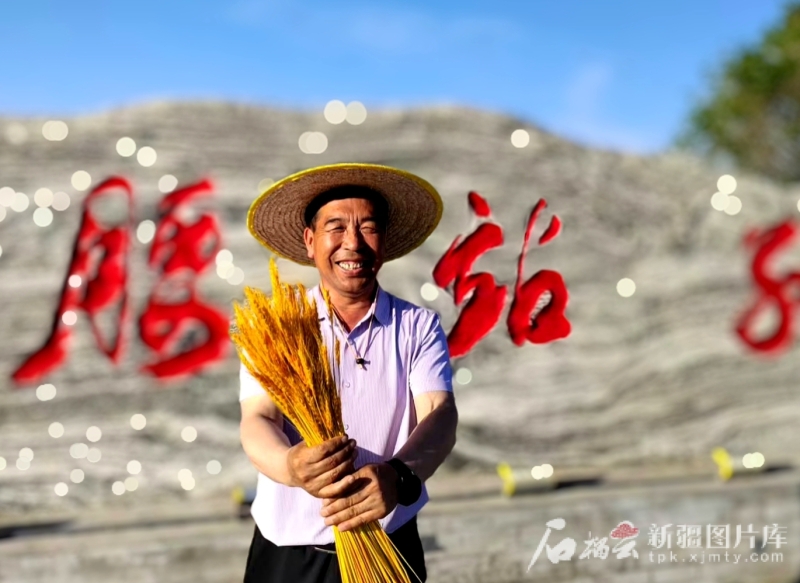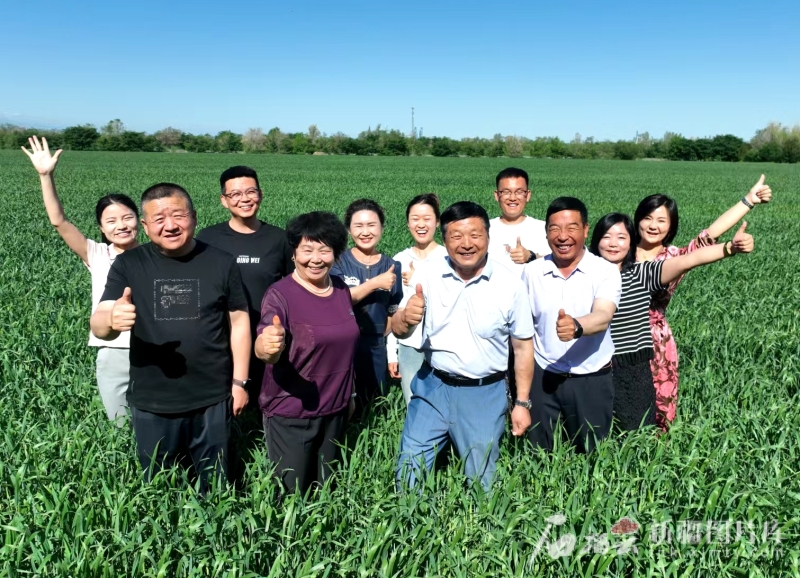Shiliuyun-Xinjiang Daily (Reporter Ge Youjun, Correspondent Wang Wei) news: As dawn breaks and the first light of morning bathes the vast wheat fields in a golden glow, Yaozhanzi Village in Banjiegou Town, Qitai County, Changji Hui Autonomous Prefecture, begins to stir. The footsteps of visitors fill the air, bringing a lively energy to the village.
Tourists linger in front of ancient plows at the Wheat Museum, meander through the laughter of families at the wheat-themed park, and encounter whimsical scarecrows in the wheat fields. From the village entrance, sightseeing vehicles pass along the floral paths, and the colorful flower fields, set against the distant snow-capped mountains, form a picturesque scene that feels entirely natural.
For Yaozhanzi Village, this is now an everyday sight. Yet for Gao Long, director of the village committee, it often brings back memories of a dream he had 16 years ago.

Photo taken on May 12, 2025 shows a villager displays wheat planted in the village in previous years in Yaozhanzi Village in Banjiegou Town, Qitai County, Changji Hui Autonomous Prefecture, northwest China's Xinjiang Uygur Autonomous Region. (Photo by Dong Xueli)
Gao Long, a native of Yaozhanzi Village, has witnessed its transformation over the years.
"More than a decade ago, the village's land was fragmented and cultivated in outdated ways. Wheat yields were low, and incomes were meager," Gao recalled on May 17.
In 2009, Yaozhanzi Village established the Qitai County Fengyu Agricultural Service Professional Cooperative, consolidating the entire village's land into a single plot for unified cultivation. The 443 households became shareholders of the cooperative, receiving both land transfer fees and year-end dividends. Gao was among the first to sign up, transferring his 115 mu (one mu equals about 666 square meters) to the cooperative.
"Initially, many were skeptical, fearing they'd lose their livelihoods," Gao said. Along with the village's Party branch secretary, Tang Peike, he visited each household to explain the benefits: "With a land transfer fee based on last year's net income of 474 yuan per mu, plus wages and dividends, it's better than working alone, right?"
In 2011, the Qitai County Fengyu Agricultural Service Professional Cooperative distributed its first dividend of 342,000 yuan (about 47,500 U.S. dollars), with Gao Long receiving 15,000 yuan (about 2,100 U.S. dollars). By 2024, the cooperative had provided dividends to its members for 14 consecutive years.
With the land consolidated, modern agricultural technologies have been increasingly adopted. Today, wheat in Yaozhanzi is sown using BeiDou Navigation Satellite System, and drones are used for pest control. The entire process, from planting to harvesting, is mechanized. Currently, the 160,000 mu of wheat and other crops that have been consolidated in Yaozhanzi are all grown organically and sustainably, with 15,000 mu dedicated to organic wheat.
As the wheels of industrial progress began to turn, Yaozhanzi Village was revitalized.
In the agricultural industrial park of Yaozhanzi Village, fully automated flour production lines operated smoothly, churning out high-quality flour that made its way into supermarkets across the country.
Gao said that this remarkable journey from the fields to the dining table began in 2017 when the village took a pivotal step by establishing Xinjiang Fengyi Agricultural Development Company. This move marked the beginning of modern green and organic farming as well as the deep processing of agricultural products, effectively creating a complete industry chain from "field to table."
Leveraging its strengths in green and organic agricultural products, in 2020, Yaozhanzi Village built an agricultural industrial park to develop the deep processing of specialty agricultural products. Since then, the village's "Yaozhanzi" brand of green and organic products, including flour, handmade noodles, edible oils, and small grains, has reached from this small village at the foot of the Tianshan Mountains to the entire country.
"The village used to be quiet, but now on weekends, the guesthouses are fully booked," Gao said. "Visitors come not only to admire the wheat fields but also to experience the traditional farming culture."

Photo taken on May 17, 2025 shows cadres and masses shoot tourism short videos in the wheat field in Yaozhanzi Village in Banjiegou Town, Qitai County, Changji Hui Autonomous Prefecture, northwest China's Xinjiang Uygur Autonomous Region. (Photo by Cheng Hongyu)
With the booming of primary and secondary industries, Yaozhanzi Village has also made significant efforts to develop all-for-one tourism. Over the past few years, the village has developed a range of attractions, including parks, a wheat museum, and a tourism commercial street, which have drawn a large number of visitors. Many villagers seized the opportunity to transform their old houses into guesthouses. During this year's May Day holiday, Yaozhanzi Village welcomed its first tourism peak, with an average of more than 3,000 visitors per day.
In 2021, the village established an incentive and welfare system, providing subsidies or bonuses to villagers with major illnesses, those aged 80 and above, families celebrating their golden or diamond wedding anniversaries, and families with outstanding students.
In 2023, the parents of Gao celebrated their golden wedding anniversary. On this special day, the couple received heartfelt blessings from friends and relatives, and they were also awarded a bonus of 2,000 yuan from the village.
In 2024, the village achieved a total output value of 510 million yuan (about 70 million U.S. dollars) across all industries, with a collective economic income of 50.4 million yuan (about seven million U.S. dollars). The average annual income per farmer and herder reached 30,600 yuan (about 4,200 U.S. dollars).
"Last year, my family received 110,000 yuan (about 15,000 U.S. dollars) in land transfer fees, and with wages, our total annual income reached 260,000 yuan (about 35,000 U.S. dollars)," Gao said.
In 2022, the village was recognized as one of the national villages with a special rural industry value exceeding 100 million yuan. It also received several national-level honors.
In line with the village's overall development plan, an initiative for rural development is currently underway in the village, with the goal of applying for national 4A-level tourist attraction status. A circular bicycle track will connect the wheat fields and flower seas, 10 charging piles will be installed at the visitor center, six high-end camping guesthouses in the elm forest have been designed, and the site for a winter skating rink is being surveyed.
"Creating a national 4A-level tourist attraction is about making visitors want to return again and again," Gao said. Standing on the village's new viewing platform, he saw the bright lights of the flour mill, the laughter from the wheat field park, and the aroma of home-cooked meals from the guesthouses. What was once a desolate area is now full of life and energy.
At that moment, Gao's phone rang. It was a call from the head of a planning and design company in Beijing: "Director Gao, we've updated the landscape design for the 4A-level tourist attraction. We propose emphasizing unique designs for each guesthouse...."
Gao said that his dream 16 years ago was to see the village's industries thrive, its people prosper, and the village itself become beautiful. Now, that dream has become a reality, and new dreams are continuing to unfold.
(A written permission shall be obtained for reprinting, excerpting, copying and mirroring of the contents published on this website. Unauthorized aforementioned act shall be deemed an infringement, of which the actor shall be held accountable under the law.)









